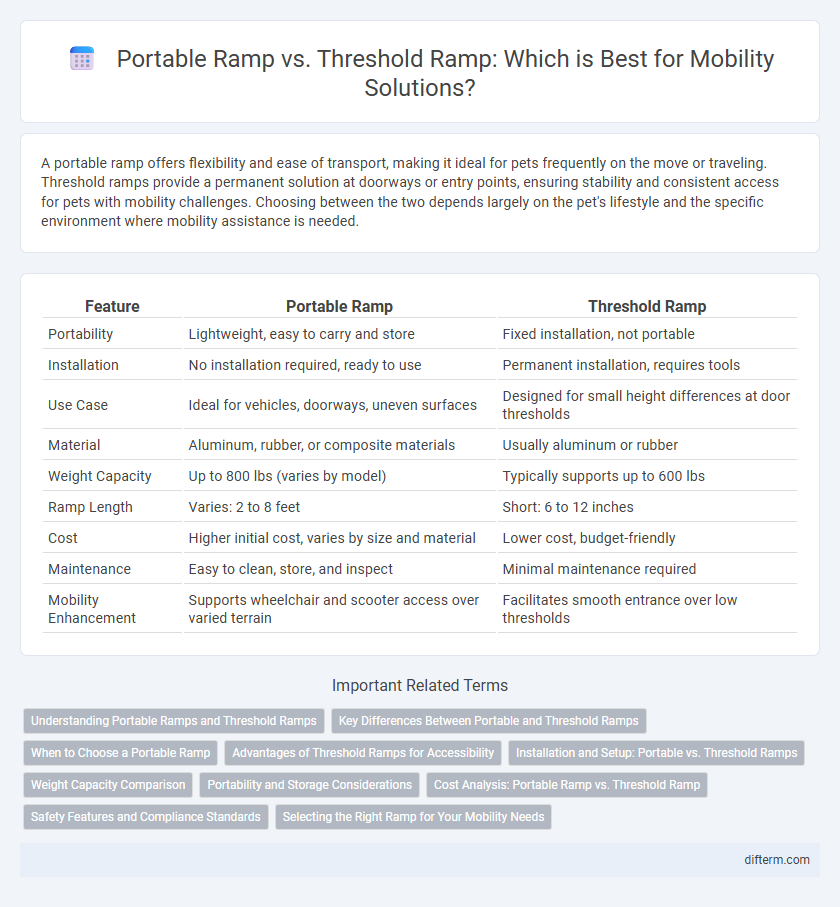A portable ramp offers flexibility and ease of transport, making it ideal for pets frequently on the move or traveling. Threshold ramps provide a permanent solution at doorways or entry points, ensuring stability and consistent access for pets with mobility challenges. Choosing between the two depends largely on the pet's lifestyle and the specific environment where mobility assistance is needed.
Table of Comparison
| Feature | Portable Ramp | Threshold Ramp |
|---|---|---|
| Portability | Lightweight, easy to carry and store | Fixed installation, not portable |
| Installation | No installation required, ready to use | Permanent installation, requires tools |
| Use Case | Ideal for vehicles, doorways, uneven surfaces | Designed for small height differences at door thresholds |
| Material | Aluminum, rubber, or composite materials | Usually aluminum or rubber |
| Weight Capacity | Up to 800 lbs (varies by model) | Typically supports up to 600 lbs |
| Ramp Length | Varies: 2 to 8 feet | Short: 6 to 12 inches |
| Cost | Higher initial cost, varies by size and material | Lower cost, budget-friendly |
| Maintenance | Easy to clean, store, and inspect | Minimal maintenance required |
| Mobility Enhancement | Supports wheelchair and scooter access over varied terrain | Facilitates smooth entrance over low thresholds |
Understanding Portable Ramps and Threshold Ramps
Portable ramps offer flexible, temporary solutions for wheelchair users, providing ease of transport and quick deployment across various locations. Threshold ramps are specifically designed to bridge small elevation changes at doorways, ensuring safe and smooth transitions over thresholds. Both ramp types enhance accessibility by addressing mobility challenges in different environments, with portability as a key feature of portable ramps and durability emphasized in threshold ramps.
Key Differences Between Portable and Threshold Ramps
Portable ramps are lightweight, easy to transport, and typically made from aluminum or composite materials, designed for temporary use and quick deployment. Threshold ramps are smaller, more durable structures intended to bridge small height differences, such as door thresholds, providing a secure, permanent or semi-permanent solution. The key differences lie in portability, size, installation ease, and suitability for various mobility needs and environments.
When to Choose a Portable Ramp
Choose a portable ramp when temporary accessibility solutions are needed for multiple locations or when space constraints limit the use of permanent installations. Portable ramps provide lightweight, easy-to-transport options ideal for overcoming obstacles like stairs or curbs in homes, vehicles, or public spaces. Their versatility and quick deployment make them suitable for short-term events, travel, or emergency access situations.
Advantages of Threshold Ramps for Accessibility
Threshold ramps offer enhanced stability and seamless integration with doorways, making them ideal for overcoming small elevation changes in homes or public buildings. Their compact design allows easy installation without extensive modifications, providing efficient access for wheelchairs, scooters, and walkers. The firm, durable materials ensure safety and durability, reducing trip hazards and supporting independence for individuals with mobility challenges.
Installation and Setup: Portable vs. Threshold Ramps
Portable ramps offer quick and straightforward installation with no permanent fixtures required, making them ideal for temporary or on-the-go mobility solutions. Threshold ramps typically require a more involved setup process, including securing them to doorways or thresholds for stability and safety. Portable ramps provide greater flexibility, while threshold ramps offer a more fixed, durable solution for frequent use.
Weight Capacity Comparison
Portable ramps typically support weight capacities ranging from 600 to 1,200 pounds, accommodating most wheelchairs and scooters with ease. Threshold ramps generally have lower weight capacities, often between 300 and 600 pounds, designed primarily for brief elevation changes. Selecting a ramp requires assessing the user's mobility device weight combined with personal load, ensuring safety and functionality.
Portability and Storage Considerations
Portable ramps are designed with lightweight materials such as aluminum, making them easy to carry and ideal for temporary accessibility needs. Threshold ramps are typically smaller, allowing for convenient storage in compact spaces like car trunks or closets while providing quick deployment at doorways. Both ramp types prioritize portability, but portable ramps offer greater versatility for varying locations, whereas threshold ramps excel in space-saving storage solutions.
Cost Analysis: Portable Ramp vs. Threshold Ramp
A portable ramp typically costs between $50 and $400 depending on length and material, offering flexibility for multiple locations without installation fees. Threshold ramps range from $20 to $150, designed for permanent use at doorways with minimal ongoing expenses but potential installation costs. Choosing between them involves weighing initial investment against portability needs and long-term durability for mobility access.
Safety Features and Compliance Standards
Portable ramps typically incorporate non-slip surfaces, raised edges, and lightweight materials to enhance user safety and ease of transport, meeting ADA (Americans with Disabilities Act) compliance standards. Threshold ramps, designed to bridge small height differences at doorways, often feature gradual slopes and durable construction to prevent tripping hazards, conforming to OSHA (Occupational Safety and Health Administration) safety requirements. Both ramp types prioritize secure installation and load capacity ratings to ensure safe mobility access.
Selecting the Right Ramp for Your Mobility Needs
Choosing the right ramp depends on your mobility requirements and the environment where it will be used. Portable ramps offer flexibility and easy transport for temporary or varying locations, while threshold ramps provide a stable, low-profile solution ideal for overcoming small elevation changes like doorways. Assessing factors such as weight capacity, incline angle, and surface type ensures optimal accessibility and safety.
portable ramp vs threshold ramp Infographic

 difterm.com
difterm.com